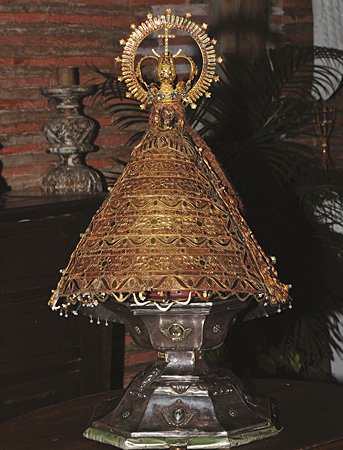Cultural Center of the Philippines
ENCYCLOPEDIA OF
PHILIPPINE ART
Our Lady of the Immaculate Conception of Caysasay / Nuestra Señora de la Inmaculada Concepcion de Caysasay / Virgin of Caysasay
Early 17th century / Wood / Approximately 27.2 cm in height / Shrine of Our Lady of Caysasay and Minor Basilica of San Martin de Tours, Taal, Batangas
The wooden image of the Immaculate Conception was allegedly found in 1603 by a fisherman named Juan Maningkad. The image was caught in Maningkad’s net at the Pansipit River and was brought immediately to Taal by Prior Fr Juan Bautista de Montoya. A big feast was held to mark the finding of the image. The image was then entrusted by Father Montoya to Taal matron Maria Espiritu. However, the image vanished from her home and was found later on the church altar. Thereafter, the image was returned to Maria but again the same thing happened. These events were considered a sign from heaven, so the image was enshrined on the church altar. However, the image also kept vanishing from the church altar only to be found on top of a sampaga tree beside a well in the midst of a nearby forest. In one of the instances when the image was found, a casaycasay or kingfisher (Halcyon chloris) was allegedly flying around the tree. Thus the name of the bird was incorporated into the title of the renowned Virgin from Taal (Barcelona 2004, 55).
The image of Our Lady of Caysasay is made of pine wood. Its paint bears traces of water damage. It is said that the image may have been lost during a shipwreck, as it was brought by Spanish soldiers who were supposed to give the image to a native community. The image itself is carved with garments resembling those worn in Europe (Galende 1987, 84). In later years, the image began being draped in queenly robes of beaten metal and cloth and adorned with a crown and an aureole of 12 stars.
Three edifices now stand as landmarks of the devotion to the Virgin of Caysasay: the Minor Basilica of San Martin de Tours (Taal Cathedral), the Shrine of Our Lady of Caysasay, and the stone arch beside the well and the sampaga tree. This well is known for its supposedly miraculous waters. The Shrine of Our Lady of Caysasay was built in 1639 near the site where the image was repeatedly found. A 120-step staircase made of Chinese granite pieces connects the Shrine of Caysasay and the Taal Cathedral. The image of the Virgin is shuttled back and forth between these two places to accommodate the wishes of her devotees. The celebration of the feast of Our Lady of Caysasay every 8 Dec is infused with colorful rituals and is popular among Chinese-Filipinos. On 8 Dec 1954, the image was honored with a pontifical coronation under the name of Pope Pius XII (Galende 1987, 84; Barcelona 2004, 55-56).
A religious komedya written by Perfecto Conde of Batangas, Batangas, titled Haybing / Comedia Religiosa, was first staged on 8 Dec 1929, and many times thereafter, dramatizing the discovery of the image and the life of a Chinaman Haybing whose life was miraculously saved by the Virgin of Caysasay (Tiongson 1999, 12-13).
Written by Dino Carlo S. Santos
Sources
Barcelona, Mary Anne. 2004. Ynang Maria : A Celebration of the Blessed Virgin Mary in the Philippines. Pasig City: Anvil Publishing Inc.
Galende, Pedro G. 1987. Angels in Stone: Architecture of Augustinian Churches in the Philippines. Manila: G.A. Formoso Pub.
Tiongson, Nicanor G. 1999. Philippine Theatre: History and Anthology / Volume 2, Komedya. Quezon City: University of the Philippines
Press.
